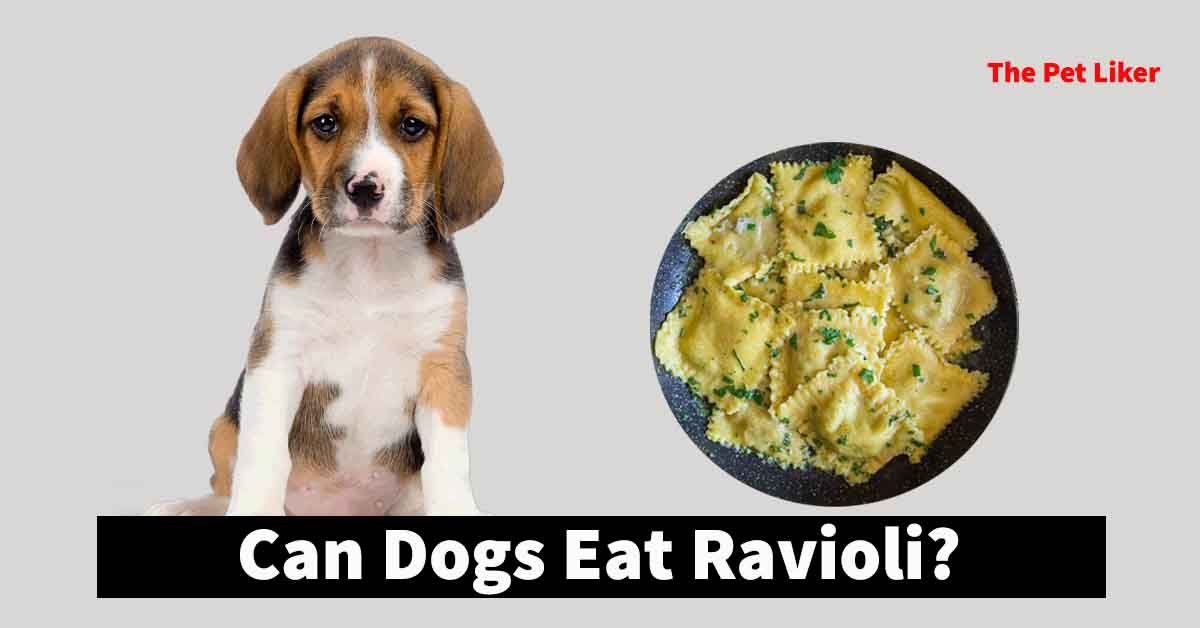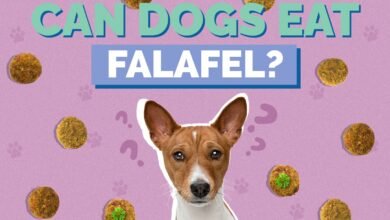
Can Dogs Eat Ravioli? If you’ve ever wondered whether this stuffed pasta is safe for your furry friend, you’re not alone. Ravioli is made with pasta dough, filled with ingredients like cheese, meat, or vegetables, and served with flavorful sauces. While it’s a tasty treat for humans, not all ravioli ingredients are safe for dogs.
Many ravioli recipes include seasonings like garlic, onion, and salt, which can harm dogs. Store-bought options may also have preservatives and artificial flavors that aren’t dog-friendly. Let’s explore what makes ravioli risky and how to make smarter choices for your pup! So, let’s find out that- Can Dogs Eat Ravioli?
Is Ravioli Safe for Dogs to Eat?
Ravioli may seem like an enticing treat to share with your dog, but it’s important to consider the ingredients before offering it to your pet. While plain, unseasoned pasta in ravioli can be safe in small amounts, the fillings, sauces, and seasonings often used can be harmful to dogs. It’s crucial to be cautious when deciding whether or not to share ravioli with your dog.
1. Plain, Unseasoned Pasta
Plain pasta without sauces or seasonings is generally safe for dogs in small amounts. It can be a simple, occasional treat, but remember to serve it in moderation.
- Offer plain ravioli without any sauces or spices.
- Make sure the pasta is well-cooked and soft to aid digestion.
- Keep portion sizes small to avoid overfeeding.
2. Harmful Fillings
Many ravioli fillings, like garlic, onion, or high-fat cheeses, are unsafe for dogs. These ingredients can cause digestive upset, toxicity, or other health issues in pets.
- Garlic and onion are toxic to dogs, even in small amounts.
- High-fat cheeses may lead to stomach discomfort or pancreatitis.
- Avoid ravioli with rich, creamy fillings or any flavoring that could harm your dog.
3. Risky Sauces
The sauces commonly paired with ravioli, such as marinara, Alfredo, or creamy sauces, often contain ingredients that are not dog-friendly. These sauces can contain high salt, sugar, or unhealthy fats, which are bad for dogs.
- Marinara sauces may include garlic, onion, or added sugars.
- Alfredo sauces are high in fat and dairy, which can upset a dog’s stomach.
- Cream-based sauces should be avoided as they can lead to digestive issues in lactose-intolerant dogs.
By carefully considering the ingredients, you can avoid giving your dog ravioli that could harm their health. Always opt for plain, simple foods to ensure your dog stays safe and happy.
Potential Risks of Feeding Ravioli to Dogs
While ravioli may seem like a fun snack to share with your dog, several potential risks come with feeding it to your pet. The combination of ingredients and seasonings in ravioli can cause a variety of health issues, from digestive upset to more serious conditions. It’s important to be aware of these risks to keep your dog safe.
1. High Sodium Content
Many ravioli dishes, especially store-bought versions, contain high levels of salt, which can be dangerous for dogs.
- Excessive salt can lead to dehydration in dogs.
- Salt poisoning can occur, causing symptoms like vomiting, diarrhea, and lethargy.
- Always check the sodium content in ravioli before offering it to your dog.
2. Rich or Fatty Fillings
Ravioli often contains rich, fatty fillings like cheese or meat, which can upset your dog’s stomach or lead to more serious conditions.
- Fatty foods can cause digestive issues like bloating or diarrhea.
- Pancreatitis is a serious risk when dogs consume high-fat foods, leading to inflammation in the pancreas.
3. Toxic Seasonings
Certain seasonings often used in ravioli, such as garlic and onion, are toxic to dogs and should be avoided at all costs.
- Garlic and onion can damage a dog’s red blood cells, potentially leading to anemia.
- Even small amounts of these seasonings can cause serious health problems.
To keep your dog safe, it’s essential to avoid feeding them ravioli with these harmful ingredients. Stick to plain, dog-friendly foods to ensure your pet stays healthy and happy.
Signs Your Dog May Have Eaten Harmful Ravioli Ingredients
If your dog has consumed ravioli with harmful ingredients, it’s important to keep a close eye on them for any signs of distress. Certain ingredients in ravioli, like garlic, onion, or rich sauces, can lead to serious health issues in dogs. Recognizing the symptoms early can help ensure prompt treatment.
1. Vomiting or Diarrhea
These are some of the most common signs that your dog has ingested something they shouldn’t have.
- Look out for frequent vomiting or diarrhea after eating ravioli.
- These digestive issues can be signs of upset stomach or food poisoning.
2. Lethargy, Weakness, or Difficulty Breathing
If your dog is acting unusually tired or showing signs of weakness, it could indicate more serious symptoms like toxicity.
- Lethargy and weakness might be signs of anemia from garlic or onion consumption.
- Difficulty breathing could be a serious reaction that needs immediate attention.
3. Increased Thirst or Unusual Behavior
Changes in your dog’s behavior or an increase in thirst can be red flags after eating harmful ingredients.
- Excessive thirst may be a symptom of dehydration caused by high salt content in ravioli.
- Watch for any other unusual behavior, like restlessness or excessive panting, which could signal distress.
If you notice any of these symptoms after your dog eats ravioli, it’s important to contact your vet right away for advice and care. Early intervention can make a big difference in your dog’s recovery.
Dog-Friendly Alternatives to Ravioli
If you’re looking to treat your dog without compromising their health, there are plenty of dog-friendly alternatives to ravioli. By choosing safer options, you can still share the joy of mealtime while keeping your furry friend safe and happy.
1. Plain, Cooked Pasta
Plain pasta without any sauces or seasoning can be a safe option for dogs in moderation.
- Cook the pasta thoroughly to make it easier for your dog to digest.
- Serve it in small portions as an occasional treat.
- Avoid adding any butter, oil, or spices.
2. Homemade Dog-Safe Ravioli
If you enjoy making ravioli at home, try creating a dog-safe version.
- Use whole wheat dough, which is gentler on your dog’s stomach.
- For the filling, opt for lean meats like chicken or turkey, avoiding high-fat ingredients.
- Skip the sauces and seasonings to keep it simple and healthy.
3. Dog-Specific Treats
There are many treats specifically designed for dogs that can offer a similar texture to ravioli without any risk.
- Choose treats made with whole ingredients like oats, pumpkin, or chicken.
- These treats are formulated to support your dog’s health and nutritional needs.
- They are often available in various shapes and textures, providing a satisfying snack.
By offering these safe alternatives, you can still pamper your pup without the risks associated with traditional ravioli. Just remember to always prioritize your dog’s health when choosing new foods or treats.
How to Prevent Your Dog From Eating Ravioli
Preventing your dog from eating ravioli is important to ensure their safety and avoid the potential risks associated with harmful ingredients. By taking a few simple steps, you can help keep your dog from getting into foods that aren’t safe for them.
1. Store Ravioli and Table Scraps Out of Reach
Keep ravioli and other food items out of your dog’s reach to reduce the temptation.
- Store food in cabinets or on high countertops.
- Use pet-proof containers to keep leftovers secure.
- Always clean up food spills immediately.
2. Train Your Dog to Avoid Counter-Surfing or Begging
Training your dog to resist the urge to grab food from the counter or beg at the table can help prevent accidents.
- Use commands like “leave it” or “stay” to control your dog’s behavior.
- Consistently reward positive behavior when your dog ignores food.
- Be patient and consistent in reinforcing these rules.
3. Stick to Dog-Specific Meals and Treats
Feeding your dog meals and treats specifically designed for them is a great way to ensure their health.
- Choose dog food that meets their nutritional needs and preferences.
- Offer healthy, safe treats made for dogs, so they don’t feel the need to beg for human food.
- Always research new treats or foods to make sure they are safe for your dog.
By following these simple steps, you can help protect your dog from the risks of eating ravioli and other human foods that could be harmful to their health.




